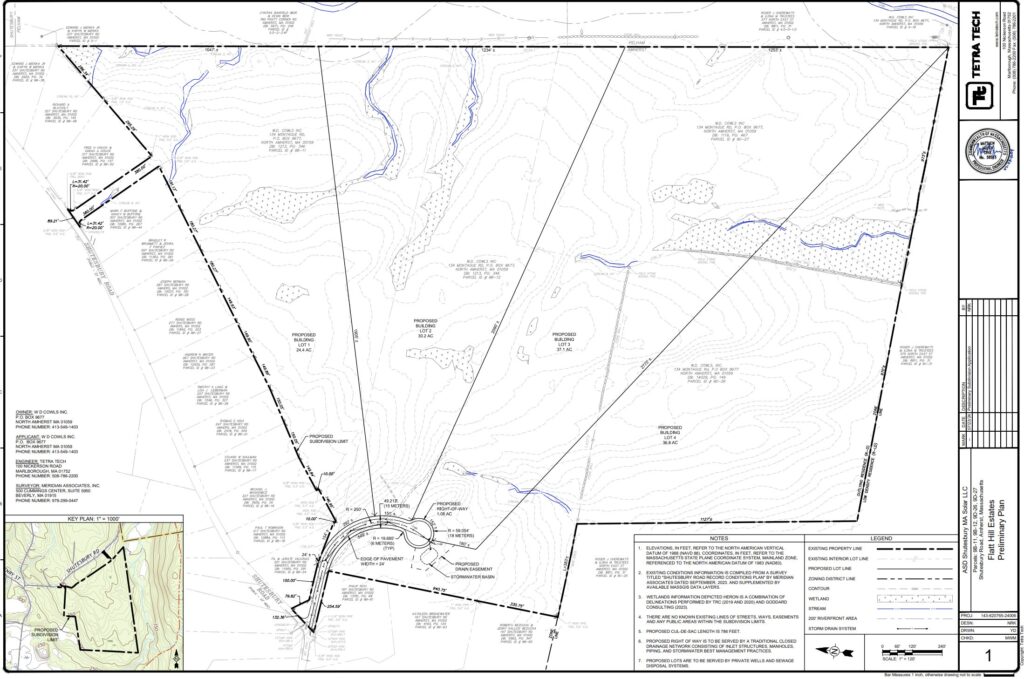Planning Board Approves “Never To Be Built” Subdivision

Photo: istock
Report on the Meeting of the Amhest Planning Board, September 4, 2024
This meeting was held over Zoom and was recorded. It can be viewed here.
Present
Doug Marshall (Chair), Fred Hartwell, Bruce Coldham, Jesse Mager, Johanna Neumann, and Karin Winter. Absent: Lawrence Kluttz.
Staff: Christine Brestrup (Planning Director), Nate Malloy (Senior Planner), and Pam Sadler Field (Assistant)
In an effort to freeze current regulations (and avoid having to comply with any new regulations for industrial solar projects that may be included in the Solar Bylaw now being evaluated by the Town Council), W.D. Cowles, Inc., owner of the parcel of land off of Shutesbury Road slated to be a 41-acre solar field, has submitted preliminary plans for a sham four-lot subdivision on a cul de sac. By submitting this preliminary subdivision plan, the company is using Massachusetts law that states that, if the preliminary plan is accepted and a definitive plan is submitted and approved within seven months, the zoning regulations applying to the land cannot be changed for eight years. The Planning Board unanimously approved the preliminary subdivision plan.
The Shutesbury Road solar project has been in discussion for several years. It has undergone a change in the siting, the solar provider, and the manufacturer of the storage batteries. Because it abuts wetlands, the Conservation Commission has been reviewing the plans. The original application expired, and the project is now again before the Conservation Commission and the Zoning Board of Appeals (ZBA).
Attorney Tom Reidy of Bacon, Wilson and Engineer Matt Moyen of Tetra Tech presented the preliminary plans for Flat Hill Estates, which proposes four lots, each over 20 acres with frontage, to be built on a cul de sac off Shutesbury Road. Because there is no public water or sewer at the site, the plans request a waiver from the requirement that prohibits private wells and septic systems in a subdivision. The application also asks for a waiver from creating a detailed plan with a scale of one-inch to 40 feet.

Planning Board member Bruce Coldham objected to the board spending time on the application “given that we know the intent of the applicant is not to proceed with a subdivision.” However, Planning Board Chair Doug Marshall and Planning Director Chris Brestrup encouraged the board to evaluate the application seriously to make sure it conforms to the Zoning Bylaw and to decide whether to grant the waivers requested. Brestrup added that this is the time for the board to request any additional information it may want included in the definitive plan.
Reidy explained that the ability to freeze zoning protects developers from having to change course mid-project and having to obtain new permits if new zoning regulations are enacted. The same tactic was used with the Center East Commons project on Main Street to protect it from the mixed-use housing bylaw changes requiring a minimum amount of non-residential space.
The Conservation Commission does not need to approve the subdivision plan, but would need to approve any structures to be built on the parcels, since all have wetland on them. Any house would also need the septic system to be approved by the Board of Health.
The Planning Board noted that there was no evaluation of the plans from the fire department. Moyen said that the turning radius on the proposed cul de sac was adequate for fire department vehicles, but the development might need a cistern to provide water for firefighting.
In order to get the freeze [on regulations], we’re really looking for the baseline subdivision that would pass muster as a subdivision…Quite candidly, there’s a per lot fee, so the more lots you have, the more money you have to pay in an application — and if you never intend to build them, why draw more?
Coldham wondered why the plans did not suggest more intensive use of the land than only four house lots. Reidy answered, “In order to get the freeze, we’re really looking for the baseline subdivision that would pass muster as a subdivision. You would only have a lot if the subdivision road provided frontage. Quite candidly, there’s a per lot fee, so the more lots you have, the more money you have to pay in an application — and if you never intend to build them, why draw more?”
Public Comment
In public comment, Michael Lipinski, whose property abuts the proposed subdivision, objected to using a housing development as an excuse to freeze the zoning for an industrial solar facility. He also wondered if the subdivision would affect the Chapter 61 protection of the land from development, which gives it a lower tax rate. Reidy explained that the zoning freeze protects the land, not the plans for development, so would apply to the Shutesbury solar project if it were built. He did not comment on the question about Chapter 61.
Sharon Weizenbaum objected to what she called an effort to bypass the interests of the public stated in the Solar Bylaw by freezing the zoning and making it easier for the proposed industrial solar project to proceed.
The Planning Board voted 6-0 to approve the preliminary subdivision plan and asked that the applicant receive direction from both the Fire Department and the Board of Health prior to submitting a definitive plan.
Status of the Shutesbury Solar Project
Planners Nate Malloy and Brestrup noted that the ZBA has not had a substantial presentation on the Shutesbury solar project since August, 2023. The board did get permission to have third-party reviewers evaluate various aspects of the plans. The main hold up, they said, is the applicant trying to figure out how to deal with the wetlands on the site, but Brestrup thought they were ready to submit a notice of intent to the Conservation Commission. Approval of the project will be handled by the Conservation Commission and the ZBA.
The Planning Board next meets on September 18. At that meeting, it will begin the public hearing on the housing proposed for 422 Amity Street, on the corner of Amity and University Drive. Board members also want an update on the Way Finders’ affordable housing project at the East Street School and 70 Belchertown Road, which is now in front of the ZBA.
